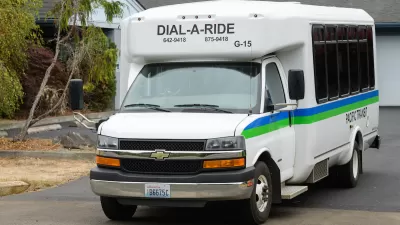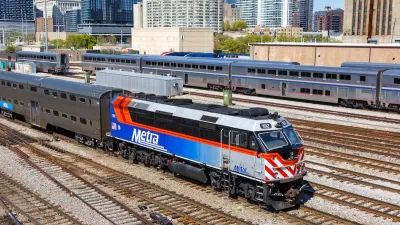On-demand microtransit is gaining popularity with transit agencies, but is it at the expense of existing service?

Transit advocates are sounding the alarm on the rapid rise of microtransit programs, which transit agencies around the country are turning to as an affordable way to supplement existing services but which some fear could undermine fixed-route services.
As Jared Brey reports in Governing, microtransit, particularly on-demand services, can help residents who aren’t otherwise well-served by transit services improve their mobility. However, “Advocates say it’s inefficient, highly expensive per rider and an opportunity cost for transit agencies that doesn’t increase ridership overall.”
Microtransit has its benefits, Brey notes, citing examples from Gwinnett County, Georgia, and Jersey City. It can vastly improve mobility options for rural residents, elderly people, and others who cannot or do not drive. But in some cases, the cost to the city is exceedingly high: programs in Los Angeles and Sacramento are costing those cities around $43 per ride.
To be fair, Brey notes, “All public transit is heavily subsidized, and many officials say it’s worth investing in options for people who don’t live near bus and train lines. But a key question is what microtransit is meant to accomplish.” For TransitCenter’s Chris Van Eyken, “Services should be judged on whether they increase overall ridership on a transit system,” and microtransit has not yet been shown to do so. The question remains whether microtransit offers “meaningful mobility at a community or city scale.”
FULL STORY: Microtransit Has Broad Appeal, Despite Clear Drawbacks

Alabama: Trump Terminates Settlements for Black Communities Harmed By Raw Sewage
Trump deemed the landmark civil rights agreement “illegal DEI and environmental justice policy.”

Study: Maui’s Plan to Convert Vacation Rentals to Long-Term Housing Could Cause Nearly $1 Billion Economic Loss
The plan would reduce visitor accommodation by 25% resulting in 1,900 jobs lost.

Planetizen Federal Action Tracker
A weekly monitor of how Trump’s orders and actions are impacting planners and planning in America.

Restoring Northern India’s Himalayan ‘Water Temples’
Thousands of centuries-old buildings protect the region’s natural springs and serve as community wells and gathering places.

Milwaukee to Double Bike Share Stations
Bublr Bikes, one of the nation’s most successful, will add 500 new e-bikes to its system.

DC Extends Application Window for Outdoor Dining Permits
District restaurants will have until the end of November to apply, but businesses with permits in rush hour parking lanes must end operations on July 31.
Urban Design for Planners 1: Software Tools
This six-course series explores essential urban design concepts using open source software and equips planners with the tools they need to participate fully in the urban design process.
Planning for Universal Design
Learn the tools for implementing Universal Design in planning regulations.
Caltrans
Smith Gee Studio
Institute for Housing and Urban Development Studies (IHS)
City of Grandview
Harvard GSD Executive Education
Toledo-Lucas County Plan Commissions
Salt Lake City
NYU Wagner Graduate School of Public Service





























